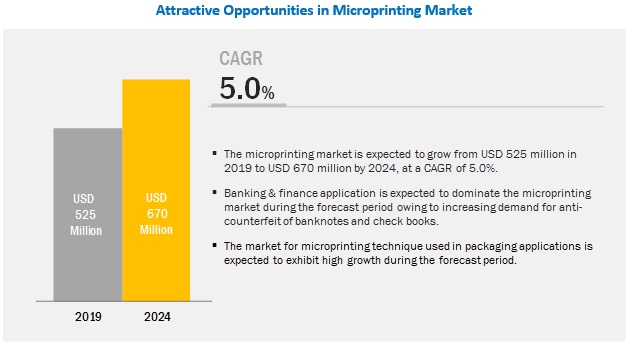Microprinting technology requires low investment. It also requires limited space for printing; it can print at high speed, as well as provides product security and traceability to avoid duplicity. Brand protection and product safety measures play an important role in all industries. Currently, food & beverages and healthcare industries are implementing microprinting technology in product packaging or item processes to protect products and brands against counterfeiting. This would, in turn, create ample opportunities for the microprinting market in the near future. According to MarketsandMarkets, the global microprinting market is expected to grow from USD 525 million in 2019 to USD 670 million by 2024, at a compound annual growth rate (CAGR) of 5.0%.
The banking and finance application is expected to hold the largest share of the microprinting market. The growth is attributed to the rising adoption of microprinting to prevent tampering or counterfeiting of banknotes, check slips, and ID cards, among others. However, all packaging industries demand brand protection and product safety as counterfeiting may affect its annual revenue. Therefore, industry players focus on implementing microprinting in packaging applications. Owing to this, the microprinting market for packaging applications is expected to grow at the highest CAGR during the forecast period.

Download PDF Brochure @
https://www.marketsandmarkets.com/pdfdownloadNew.asp?id=216162103
Color type is expected to hold a larger share of the microprinting market. This is mainly attributed to the wide acceptance of color-based microprinting in government, and banking and finance applications. Almost all banknotes, check books, a few ID cards, and postage stamps use color microprinting. Moreover, this growth is mainly due to rising demand for counterfeit deterrence in banknotes and check slips.
In terms of geographic coverage, the microprinting market has been segmented into 4 regions, namely, North America, Asia Pacific (APAC), Europe, and Rest of World (RoW). APAC is expected to be the fastest-growing region in the microprinting market. APAC is witnessing increasing use of microprinting technology-based printers owing to the presence of a large number of banking and finance organizations, government agencies, and corporate companies. The banking and finance sector of China, Japan, and India are heavily deploying microprinting technology while designing banknotes and check books. Increasing incidences of fraudulent activities and introduction of fake currency are factors that help spur the growth of the microprinting market. Moreover, as China and India are among the populated countries, there is an increase in demand for official and government documents such as ID cards, driving licenses, national ID cards, passports, and official gadget documents. This demand is further expected to provide significant opportunities for the microprinting market in APAC.

